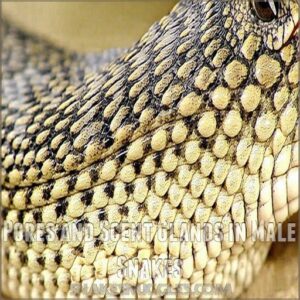This site is supported by our readers. We may earn a commission, at no cost to you, if you purchase through links.

Look for tail differences – males typically have thicker, longer tails to accommodate their reproductive organs.
Check for anal spurs near the vent; males usually have more pronounced ones.
Size matters too, but it varies by species – some males are larger, while in others, females take the size crown.
For definitive answers, you’ll need specialized probing techniques or to examine the presence of hemipenes. Just like solving a puzzle, each characteristic gives you another piece of the gender mystery.
Table Of Contents
- Key Takeaways
- Methods for Determining Snake Gender
- How to Tell a Snake’s Gender
- Physical Characteristics of Male and Female Snakes
- Behavioral Differences Between Male and Female Snakes
- Age and Sexual Maturity Factors in Snakes
- Limitations and Challenges of Snake Sex Determination
- Snake Mating Systems and Behaviors
- Identifying Sex Through Physical Characteristics
- Snake Reproduction and Pregnancy
- Choosing The Right Pet Snake Species
- Frequently Asked Questions (FAQs)
- How can you tell if a snake is a boy or girl?
- How to tell a ball python’s gender?
- What are gender differences in snakes?
- Is snake masculine or feminine?
- Do snakes change gender based on temperature?
- How often should snakes be checked for gender?
- Can DNA testing determine a snakes gender?
- What equipment is needed for snake gender probing?
- Are captive-bred snakes easier to gender identify?
- Conclusion
Key Takeaways
- You’ll find male snakes have thicker and longer tails than females, as they need the extra space to house their reproductive organs called hemipenes.
- You can spot males by checking for pronounced anal spurs near the vent and more prominent pores along their belly scales for releasing pheromones.
- You’ll need to wait until your snake reaches sexual maturity (typically 6 months to 2 years) before gender differences become clearly visible.
- You shouldn’t attempt probing yourself, as incorrect technique can harm your snake – instead, have a veterinarian or experienced breeder determine the gender.
Methods for Determining Snake Gender
Figuring out a snake’s gender can be tricky, but with the right methods, you’re set to become a snake sexing superstar.
You can check tail shape, look for pores, or use a probe to find hemipenes,
just don’t let that slithery friend outsmart you!
Size and Shape Analysis
Size differences can tell a tale.
Male snakes often boast longer tail lengths and thicker bodies—nature’s quirky way of hinting at snake gender identification.
Specifically, males tend to have tails that taper differently, starting thick and then suddenly thinning out at the tip, a characteristic that can be used in snake tail analysis.
Add head size and weight variation to the mix, and you’ve got a detective puzzle worthy of Sherlock Holmes.
Remember, these clues aren’t foolproof but give insights into snake sexing nuances.
Pores and Scent Glands Examination
When checking out snake gender, have you noticed those tiny secrets beneath? Males often flaunt more prominent pores and scent glands for marking territory and attracting mates.
These glands reveal:
- Scent gland function and pheromone role
- Variations depending on the species
- Location near the belly, showcasing snake anatomy
- Presence of anal spurs in some species
Keep an eye out, and you’ll spot these cues!
Probing With Snake Sexing Probes
Determining a snake’s sex often involves a technique known as visual inspection methods such as checking tail shape and scale count. Determining a snake’s sex often involves a probing technique.
Using a blunt probe, you carefully insert it into the snake’s cloaca.
If you feel something, it’s a hemipene—a male’s reproductive organ.
While accurate, probing requires gentle handling and proper safety precautions.
Remember, alternative methods exist, and ethical considerations are always important in snake sexing.
Always prioritize the snake’s well-being.
Visual Cues and Color Pattern Differences
Understanding the intricate aspects of snake morphs and their genetic variations and inheritance can provide valuable insights into snake biology. Spotting snake color variations and sex-specific markings can be tricky—it’s like playing detective with scales.
In some species, males might flaunt brighter hues, while females stick to more muted tones.
Others showcase unique patterns, making color-based sex determination a puzzle.
To better understand these variations, you can also explore products related to snake color variation products.
Keep an eye on these subtle hints—nature’s camouflage adaptations vary widely among snake species, spotlighting sexual dimorphism beautifully!
How to Tell a Snake’s Gender
You’ll be surprised to learn that telling a snake’s gender isn’t as straightforward as checking under its tail, but there are several reliable methods that experts use to determine whether you’ve got a male or female serpent.
snake gender identification involves examining specific physical characteristics like tail length, cloacal features, and pore patterns.
Whether you’re a curious pet owner or aspiring herpetologist, you’ll discover that snake gender identification involves examining specific physical characteristics like tail length, cloacal features, and pore patterns.
Tail Shape and Length Analysis
The tail tells a fascinating story about your snake’s gender.
Male snakes typically sport longer, thicker tails than their female counterparts – it’s nature’s way of housing their reproductive organs.
Here’s what to look for:
- The base of a male’s tail stays thick for a longer distance
- Female tails taper more quickly and appear shorter
- Tail proportions vary by species, so know your snake’s breed
Hemipene Identification and Probing
Snake probing might sound tricky, but it’s one of the most reliable ways to identify gender.
When carefully inserted into the cloaca, a smooth probe will travel deeper in males due to their hemipenes – paired reproductive organs.
You’ll need steady hands and proper training though, as this method requires precision.
Think of it like finding a hidden pocket that’s only present in male snakes.
Cloacal Bulge and Spurs Examination
Looking closely at a snake’s underside can reveal fascinating gender clues. After probing, you’ll want to check for a cloacal bulge – that telltale bump near the tail that screams "male!" in many species, especially ball pythons. You’ll also spot spurs, those tiny claw-like structures that males typically show off.
- Picture a tiny speed bump just past the snake’s vent
- Think of miniature cat claws on either side
- Imagine feeling for marble-sized lumps
- Visualize paired scales that look like fingernails
- Think of matching sharp points, like tiny thorns
Evaluating Size and Weight Differences
When examining physical traits, you’ll notice size differences between male and female snakes vary by species.
Take ball pythons – females typically outweigh males by 25-30%.
But here’s the catch: weight isn’t always a reliable indicator.
Some male snakes can match or exceed female sizes, especially during breeding season.
Your best bet? Consider size alongside other physical characteristics for accurate gender determination.
Physical Characteristics of Male and Female Snakes
You’ll find that male and female snakes have distinct physical features that can help you tell them apart, like the males’ longer tails and more prominent pores on their undersides.
If you’re looking at your pet snake right now, you can spot these differences by checking the tail length and thickness, which is usually greater in males due to their reproductive organs called hemipenes.
Recognizing Sexual Dimorphism in Snakes
Sexual dimorphism in snakes might sound complicated, but it’s just a fancy way of saying males and females look different.
You’ll notice male snakes often have thicker, longer tails to house their reproductive organs, while females typically sport shorter, thinner tails.
In many species, females grow larger overall – nature’s way of preparing them for carrying eggs or babies.
Color Pattern Differences Between Genders
Color differences between male and female snakes can be subtle yet revealing.
Ball pythons showcase this trait well – males often sport darker, more intense patterns with black or dark brown variations, while females tend toward lighter, more muted tones.
Find female snake color variations at snake accessories stores like female snake accessories.
Keep in mind though, these differences aren’t universal across species.
Some snakes, like corn snakes, show virtually no color variation between genders.
Cloacal Spurs and Hemipene Identification
A snake’s cloacal spurs hold the key to determining its gender, much like nature’s own ID card. Think of these small, claw-like structures as biological markers that tell quite a story. For those interested in learning more, there are products and resources available for studying snake cloacal spurs snake anatomy tools. Here’s what to look for:
- Male snakes typically have longer, more prominent spurs near their cloaca
- Hemipenes appear as paired bulges when gently probed
- Female spurs are usually smaller or absent
- Probing depth varies greatly between genders
Pores and Scent Glands in Male Snakes
Many male snakes have specialized pores along their belly scales that produce powerful pheromones.
These scent glands play a key role in marking territory and attracting mates.
Here’s a quick comparison of pore characteristics between species:
| Species | Male Pore Size | Female Pore Size | Location | Scent Output |
|---|---|---|---|---|
| Ball Python | Large | Tiny/None | Pre-anal | High |
| Corn Snake | Medium | Minimal | Ventral | Moderate |
| Boa | Large | None | Pre-anal | Very High |
| Garter Snake | Small | None | Ventral | Low |
| Copperhead | Medium | Minimal | Pre-anal | Moderate |
Behavioral Differences Between Male and Female Snakes
You’ll notice that male snakes tend to be more territorial and aggressive during mating season, often engaging in wrestling matches with other males to win breeding rights.
Female snakes show their own unique behaviors too, as they’ll spend more time seeking out perfect nesting spots and may become more defensive when they’re preparing to lay eggs.
Territorial Behavior in Male Snakes
Understanding territorial behavior in male snakes reveals key gender clues.
You’ll notice male snakes often displaying dominance through raised heads and aggressive posturing, especially around breeding season.
They’ll actively defend their turf using scent marking and resource guarding.
If you spot a snake showing these defensive strategies, chances are you’re dealing with a male displaying his authority over his domain.
Mating Habits and Rituals in Snakes
Regarding snake mating habits, you’ll witness quite a show. During mating season, male snakes release pheromones and perform intricate courtship dances to attract females.
They’ll often compete for attention through fascinating displays of dominance:
- Males intertwine their bodies in ritualistic combat dances
- Successful suitors gently bite the female’s neck during courtship
- Both partners align their cloacal openings for successful mating
Asexual Reproduction in Some Snake Species
Some snake species possess nature’s ultimate superpower – they can reproduce without a mate through parthenogenesis.
You’ll find this fascinating ability in Brahminy blind snakes and certain python species, where females create perfect genetic copies of themselves.
Environmental factors often trigger this facultative reproduction, giving these resourceful reptiles an evolutionary advantage when males are scarce.
It’s like nature’s backup plan for species survival.
Age and Sexual Maturity Factors in Snakes
You’ll find it easier to determine your snake’s gender once it reaches sexual maturity, which typically happens between 6 months to 2 years depending on the species.
Just like teenagers hitting puberty, your snake will develop distinct physical characteristics that make gender identification more reliable, including changes in size, tail shape, and the development of reproductive organs.
Reaching Sexual Maturity in Snakes
Most snakes follow a fascinating journey to sexual maturity that depends on several key factors.
Here’s what drives their development:
- Body size matters more than actual age for reaching maturity
- Female snakes typically need extra time to mature compared to males
- Environmental conditions, like temperature and food availability, play a huge role in timing
Think of it like nature’s way of ensuring they’re ready for the dating scene!
Species-Specific Age Requirements
Sexual maturity in snakes varies dramatically by species.
Ball pythons reach maturity at 2-3 years, while corn snakes, like snow corn snakes that inherit their unique appearance due to recessive mutations of anerythrism and amelanism traits, are ready to breed at 18-24 months.
You’ll find boa constrictors taking 3-4 years, and some larger species like Burmese pythons need 4-6 years.
If you’re planning to breed, it’s important to know these timelines since rushing breeding can stress your snake and lead to health issues.
Physical Changes at Maturity
Your snake’s journey to maturity brings fascinating physical transformations.
Like teenagers hitting their growth spurt, snakes undergo dramatic changes in size and appearance.
You’ll notice distinct shifts in body proportions, with males developing longer, thicker tails and prominent hemipenes near their cloaca.
- Watch for that "teenage snake" growth spurt – they can double in size surprisingly fast!
- Notice their colors becoming more vibrant, like nature’s own paint job
- Keep an eye on tail development – it’s their personal signature of maturity
Behavioral Changes at Maturity
Once snakes reach maturity, their personalities can shift dramatically.
You’ll notice male snakes becoming territorial daredevils, often picking fights during mating season.
Meanwhile, female snakes might start acting like real estate agents – scouting perfect nesting spots and getting pickier about their basking locations.
Their appetites change too, with females typically eating more to prepare for potential breeding.
Watch for these telltale behavioral shifts!
Limitations and Challenges of Snake Sex Determination
You might think determining a snake’s gender is as simple as checking under their tail, but even experienced reptile handlers can struggle with accurate identification due to the subtle nature of gender markers in many snake species.
While there are several methods available for sexing snakes, each comes with its own set of challenges that can make getting a definitive answer trickier than you’d expect.
Limitations of Sex Determination Methods
Determining a snake’s gender isn’t always straightforward, even for experienced handlers.
While methods like probing and visual inspection can help, they’re not foolproof.
For instance, tail shape differences are often relied upon, but species-specific variations can throw off even careful observations – what works for a ball python mightn’t apply to a corn snake.
Plus, young snakes often lack clear gender markers, making accurate identification a real challenge until they reach maturity.
Health Risks Associated With Popping and Probing
Several serious health risks lurk behind improper snake sexing techniques.
Popping and probing can cause severe stress, internal trauma, and infections if done incorrectly.
Think of it like performing surgery – one wrong move and you could harm your scaly friend.
Even when done carefully, these methods can lead to bleeding, tissue damage, or cloacal infections.
It’s important to weigh these risks against the necessity of gender determination.
Importance of Experience and Expertise
Properly identifying a snake’s gender requires specialized knowledge and hands-on practice.
While probing might seem straightforward, mishandling can harm your snake.
You’ll want to learn from an experienced reptile vet or breeder who can demonstrate safe techniques.
Think of it like learning to drive – you wouldn’t hit the highway without lessons first.
Building expertise takes time, patience, and careful observation.
Consulting Breeders and Pet Stores for Sex Identification
Many experienced snake breeders and reputable pet stores offer professional sexing services, though prices can vary from complimentary to $85. Reputable breeders, such as ball python ethical breeders, typically provide this service for free or at a reasonable cost, though prices can vary from complimentary to $85.
You’ll want to research their track record and ask about their specific methods – probing, popping, or visual identification.
While these experts can usually determine your snake’s sex accurately, it’s worth getting a second opinion, especially for rare or valuable specimens.
Snake Mating Systems and Behaviors
You’ll find that snakes have some truly fascinating mating rituals, from the male’s unique double-penis adaptation to the female’s selective mate choice based on size and strength.
mating behavior
If you’re wondering about identifying snake gender through mating behavior, you’ll notice that males often wrestle with each other to win breeding rights, while females focus on finding the perfect spot to lay their eggs.
Garter Snake Mating Habits
Garter snake mating season kicks off with a fascinating sight – dozens of males pursuing a single female in what experts call a ‘mating ball,’ which is also known as a display of intense sperm competition.
You’ll spot these breeding balls emerging from winter dens in early spring.
Unlike other snake species, female garter snakes can store sperm for years, allowing them to produce multiple broods without additional mating.
This unique adaptation helps their survival in varying conditions.
One-on-One Mating Rituals
Snake mating rituals are like an intimate dance where males pursue females through a series of graceful courtship displays.
You’ll notice males trailing their potential mates, flicking their tongues to pick up pheromone signals.
During these encounters, they’ll wrap around the female and perform gentle pressing movements.
Some species even engage in spectacular combat dances, where males wrestle to win mating rights.
Double-Penis Adaptation and Mating Strategies
You might be surprised to learn male snakes come equipped with not one, but two reproductive organs called hemipenes.
These twin adaptations give them quite the evolutionary advantage.
During mating, they’ll use whichever hemipene is closest to the female’s cloaca – talk about efficient design!
Here’s what makes this double-trouble setup so fascinating:
- Better chances of successful mating in tricky positions
- Increased genetic diversity through multiple partner options
- Improved sperm delivery and storage capabilities
Asexual Reproduction in Snakes
Believe it or not, some female snakes can reproduce without males through parthenogenesis – nature’s version of a solo act.
This remarkable process, triggered by environmental factors, allows females to create offspring that are genetic clones of themselves.
While it’s relatively rare, species like Brahminy blind snakes and some pythons have mastered this evolutionary trick, though it reduces genetic variation.
Identifying Sex Through Physical Characteristics
You’ll find that telling a snake’s gender isn’t as tricky as you might think, once you know the key physical markers like tail length and scale patterns.
Just like checking under the hood of a car, you can spot the differences between male and female snakes by examining specific features such as their pores, hemipenes, and even the shape of their tails.
Color Pattern Differences
Regarding color patterns, identifying your snake’s gender isn’t as straightforward as checking for pink or blue scales.
Many species show subtle differences – males often display brighter, more vibrant patterns during breeding season.
Keep in mind that geographic variations and individual genetics play a huge role too.
While some species like garter snakes show distinct sexual dimorphism, it’s not a foolproof method.
Pores and Scent Glands
Looking under a snake’s scales reveals a fascinating world of scent communication.
Males typically have larger, more prominent pores along their belly scales for releasing pheromones.
Here’s what to look for:
- Check for a row of raised dots along the snake’s belly scales
- Compare the size – male pores are usually more prominent
- Look for oily secretions around the pores during breeding season
Snake Reproduction and Pregnancy
You’ll notice significant changes in your female snake’s body when she’s pregnant, including a swollen belly and rapid weight gain that might make her look like she’s had an all-you-can-eat mouse buffet.
If you’re planning to breed snakes, you’ll need both a male and female since snakes can’t reproduce on their own (except for a few rare species that don’t need a date to make babies).
Female Snake Pregnancy Signs
Spotting a pregnant snake isn’t as tricky as you might think.
Your female snake will show clear signs like a noticeably swollen belly, especially in the middle section.
You’ll also notice rapid weight gain and increased size, even when maintaining their usual diet.
Watch for changes in behavior too – she might become more reclusive and show nesting behaviors, like searching for dark, quiet spots.
Snake Water Intake and Hydration
After keeping tabs on pregnancy signs, let’s talk about how snakes stay hydrated. You might be surprised to learn that snakes don’t lap up water like cats or dogs. Here’s how they handle their H2O needs:
- They collect water droplets from their scales after rain or misting
- Some snakes soak their entire body in shallow water
- Most can absorb moisture through their skin while bathing
Snake Reproduction and Behavior
Snake reproduction isn’t just about the birds and bees – it’s a complex dance of hormones and behaviors.
You’ll notice females developing a rounded belly and showing increased basking behavior during pregnancy.
Male snakes perform intricate courtship rituals, including tongue flicking and body alignment.
Both genders display distinct reproductive behaviors: males actively search for mates, while females focus on finding safe nesting spots.
Female Anaconda Behavior After Mating
Female anacondas display one of nature’s most fascinating post-mating behaviors.
You’d be surprised to learn they often consume their male partners after breeding, a practice that provides important nutrients for gestation.
This unique behavior is important for female anacondas, who can grow up to 29 feet long and weigh as much as 500 pounds in the wild.
This cannibalistic behavior supplies extra energy for egg development.
Males, being considerably smaller, can’t escape once chosen.
Females can store the nutrients for up to 7 months during pregnancy.
Choosing The Right Pet Snake Species
You’ll find that choosing your first pet snake becomes much easier once you understand the gender differences, as males and females of certain species have distinct care requirements and temperaments.
The unique genetic combination of a Candino ball python’s ancestry often draws enthusiasts to specific species, and understanding the nuances of each can greatly impact the care process. Whether you’re considering a docile corn snake or a more challenging species like a ball python, knowing your snake’s gender will help you create the perfect habitat and care routine for your scaly friend.
User-Centric Designs Impact
When choosing your first pet snake, you’ll want an enclosure design that matches both your lifestyle and the snake’s needs.
Researching different species, such as the popular pet snake species, can help you determine the right fit.
Your setup should prioritize easy feeding, cleaning, and monitoring while keeping your snake secure and comfortable.
Consider features like front-opening doors, proper ventilation, and accessible water bowls.
When preparing snakes for breeding, it’s essential to select snakes based on age, sex, weight, overall health, and temperament, considering factors such as ambient conditions for breeding. Remember, what works for a ball python mightn’t suit a corn snake’s climbing habits.
Balancing Functionality And Aesthetics
Choosing the perfect snake enclosure means finding that sweet spot between looks and functionality.
You’ll want to create a space that’s both a stunning showpiece and a comfortable home for your scaly friend.
Think of it as designing a miniature ecosystem that works seamlessly with your home’s aesthetic.
- Natural cork bark walls that double as climbing surfaces
- LED lighting systems that mimic natural daylight cycles
- Bio-active substrates that maintain humidity while looking forest-fresh
Inclusive Accessibility Features
The right snake companion depends heavily on your specific needs and accessibility requirements.
You’ll want to think about factors like handling ease, visual distinctiveness, and care complexity.
Here’s a helpful breakdown of popular snake species and their accessibility features:
| Species | Handling Ease | Visual ID | Care Level | Care Cost |
|---|---|---|---|---|
| Corn Snake | Easy | High | Simple | Low |
| Ball Python | Moderate | Medium | Moderate | Medium |
| Rosy Boa | Very Easy | High | Simple | Low |
| King Snake | Easy | High | Simple | Medium |
| Garter Snake | Easy | High | Simple | Low |
Frequently Asked Questions (FAQs)
How can you tell if a snake is a boy or girl?
Probing precisely permits proper python perception!
You can tell a snake’s sex by examining tail thickness (males are thicker), checking for pores underneath, or having a vet perform safe probing of the cloaca.
How to tell a ball python’s gender?
You’ll spot a male ball python by its thicker, longer tail and cloacal bulge near the vent.
For females, look for a shorter, thinner tail and larger overall size as they reach maturity.
What are gender differences in snakes?
Male snakes typically have longer, thicker tails and more prominent pores for releasing pheromones, while females tend to be larger overall.
Behavioral differences exist too, with males showing more territorial traits during mating season.
Is snake masculine or feminine?
Snakes don’t have inherent gender associations like some animals do – they’re neither masculine nor feminine.
In the wild, both male and female snakes play equally important roles in their ecosystems and survival.
Do snakes change gender based on temperature?
Unlike the chameleon’s million color changes, snakes don’t swap genders with temperature.
Their sex is determined at fertilization and stays fixed throughout their lives, just like most reptiles you’re familiar with.
How often should snakes be checked for gender?
Once your snake reaches maturity (usually 6-12 months), you’ll only need to check their gender once, unless you’re breeding.
The initial determination by a vet or experienced handler is typically permanent.
Can DNA testing determine a snakes gender?
Yes, DNA testing can accurately determine your snake’s gender through blood or tissue samples. While it’s more expensive than traditional methods, you’ll get definitive results from a certified veterinary laboratory.
What equipment is needed for snake gender probing?
You’ll need a professional snake probing kit that includes stainless steel probes of varying sizes, lubricant, antiseptic solution, and clean gloves.
It’s best to have an experienced handler guide your first attempt.
Are captive-bred snakes easier to gender identify?
Captive-bred snakes are typically easier to gender identify because they’re handled more frequently from birth, making them calmer during examinations.
Breeders often maintain detailed records of their physical development and characteristics.
Conclusion
Did you know that 85% of snake enthusiasts initially struggle to tell the gender of a snake?
Armed with the knowledge of tail differences, spurs, and size variations, you’re now better equipped to determine your serpentine friend’s gender.
While learning how to tell the gender of a snake takes practice, these expert tips provide a solid foundation.
Remember, when in doubt, consult a reptile veterinarian or experienced breeder – they’ll help you master these techniques and verify accurate identification.




















